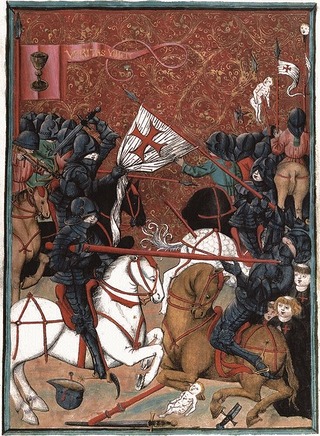
The Hussites were a Czech proto-Protestant Christian movement that followed the teachings of reformer Jan Hus, who became the best known representative of the Bohemian Reformation.

John Amos Comenius was a Moravian philosopher, pedagogue and theologian who is considered the father of modern education. He served as the last bishop of the Unity of the Brethren before becoming a religious refugee and one of the earliest champions of universal education, a concept eventually set forth in his book Didactica Magna. As an educator and theologian, he led schools and advised governments across Protestant Europe through the middle of the seventeenth century.
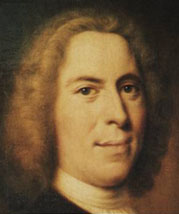
Nikolaus Ludwig, Reichsgraf von Zinzendorf und Pottendorf was a German religious and social reformer, bishop of the Moravian Church, founder of the Herrnhuter Brüdergemeine, Christian mission pioneer and a major figure of 18th-century Protestantism.

Petr Chelčický was a Czech Christian spiritual leader and author in the 15th century Bohemia, now the Czech Republic. He was one of the most influential thinkers of the Bohemian Reformation. Petr Chelčický inspired the Unitas Fratrum, who opposed transubstantiation and monasticism, insisting on pacifism and the primacy of scripture. There are multiple parallels with the teachings of the Anabaptists and Petr Chelčický. Czech Baptists have also expressed continuity with the Bohemian reformation by identifying with Petr Chelčický.

Moravian University is a private university in Bethlehem, Pennsylvania. The institution traces its founding to 1742 by Moravians, descendants of followers of the Bohemian Reformation under John Amos Comenius. Founded as a girls school in 1742, the College itself was founded as the Moravian College and Theological Seminary in 1807 and was accredited in 1863. In 2021, the College was elevated to a University. Moravian University uses the foundation of the Girls school as their foundation date which makes them the sixth-oldest college in the United States.

The Moravian Church, or the Moravian Brethren, formally the Unitas Fratrum, is one of the oldest Protestant denominations in Christianity, dating back to the Bohemian Reformation of the 15th century and the Unity of the Brethren founded in the Kingdom of Bohemia, sixty years before Luther's Reformation.

Fulnek is a town in Nový Jičín District in the Moravian-Silesian Region of the Czech Republic. It has about 5,500 inhabitants. The historic town centre is well preserved and is protected by law as an urban monument zone.

Fulneck Moravian Settlement is a village in Pudsey in the City of Leeds metropolitan borough, West Yorkshire, England. The village lies on a hillside overlooking a deep valley. Pudsey Beck flows along the bottom of the valley.

Peter Bohler was a German-English Moravian bishop and missionary who was influential in the Moravian Church in the Americas and England during the eighteenth century. Some people (incorrectly) spell his last name as Boehler.
This article covers the period from the origin of the Moravian Church, as well as the related Hussite Church and Unity of the Brethren, in the early fourteenth century to the beginning of mission work in 1732. Further expanding the article, attention will also be paid to the early Moravian settlement at Bethlehem, Pennsylvania, following their first arrival in Nazareth, Pennsylvania in 1740.

The Moravian Church of the British Province is part of the worldwide Moravian Church Unity. The Moravian Church in Britain has bishops in apostolic succession.
The Jamaica Province of the Moravian Church is part of the worldwide Moravian Church Unity.
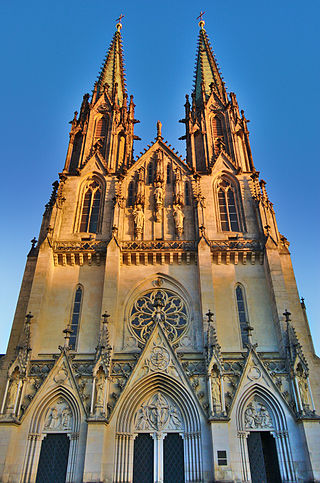
In the Czech Republic, 47.8% of population is irreligious, while 21.3% of the population are believers. The religious identity of the country has changed drastically since the first half of the 20th century, when more than 90% of Czechs were Christians. As of 2021, 11.7% of the population identified with Christianity whilst 10.8% identified with other religious identities or beliefs. According to sociologist Jan Spousta, not all the irreligious people are atheists; indeed, since the late 20th century there has been an increasing distancing from both Christian dogmatism and atheism, and at the same time ideas and non-institutional models similar to those of Eastern religions have become widespread through movements started by various gurus, and hermetic and mystical paths.
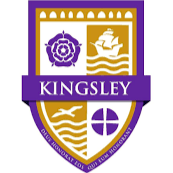
Kingsley School Bideford is a co-educational independent school in Bideford, Devon. The school was founded in 1884 as Edgehill College, and merged with Grenville College in 2009 to form Kingsley.

Fairfield Moravian Church and its surrounding settlement was founded in 1785 in Fairfield, Droylsden, Lancashire, England. It was founded by Benjamin La Trobe as a centre for evangelistic work for the Moravian Church in the Manchester area. Numbers 15, 28 and 30 Fairfield Square are Grade II* listed buildings.

Fulneck Moravian Church and its associated settlement were established on the Fulneck estate, Pudsey, in the West Riding of Yorkshire, England, in 1744 by Count Nicolaus Ludwig von Zinzendorf, a Moravian Bishop and Lutheran priest, following a donation of land by the evangelical Anglican clergyman, Benjamin Ingham. Fulneck is now part of the City of Leeds, West Yorkshire.

Benjamin Ingham was an English cleric who was the founder of the Moravian Church in England as well as his own Inghamite societies.
Henry Antes was an early 18th-century settler of Pennsylvania, an architect and builder and a leader of the Congregation of God in the Spirit and then the Moravian Church. He is considered one of the most important religious/political leaders of the time, specifically because he preached tolerance and understanding.

Bishop Challoner Catholic School is a Roman Catholic comprehensive secondary school and sixth form, located in the Shadwell area of the London Borough of Tower Hamlets, England.
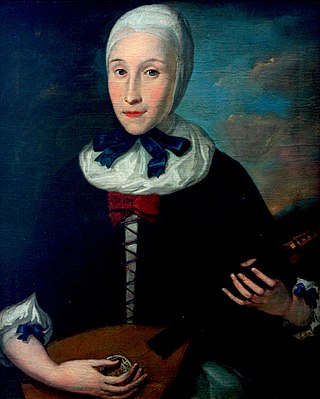
Benigna Zinzendorf, also known as Henrietta Benigna Justine Zinzendorf von Watteville (1725–1789), was the founder of the first boarding school for girls in the British American colonies, which became Moravian University and Moravian Academy. She was a missionary among Native Americans and assisted her father, Count Nicolaus Zinzendorf, and her husband, Bishop Johannes Langguth, in their religious activities in Europe and America. She enjoyed music and was an Eldress to girls' choirs beginning at the age of 14 and was a leader in an adult choir after she was married.
















